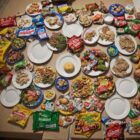Maximizing Nutrition Through Food Stamp Programs: a Guide

You might be thinking, ‘Can I really maximize my nutrition through food stamp programs?’ The answer is yes!
This guide will show you how to make the most of your food stamps by providing practical strategies for budgeting, meal planning, and smart shopping.
With a little knowledge and some helpful tips, you can prioritize nutritious foods and make healthy choices that will nourish you and your family.
It’s time to unlock the full potential of your food stamp benefits.
Key Takeaways
- Food stamp programs provide improved access to nutritious food and financial assistance to stretch food budgets.
- Eligibility requirements for food stamp programs include being a United States citizen or qualified noncitizen, having income at or below 130% of the federal poverty level, and limited assets.
- Food stamp benefits may not cover the entire monthly food budget and certain items may not be eligible for purchase.
- Maximizing nutrition through food stamp programs can be achieved by creating a meal plan, making a shopping list based on the plan, avoiding impulse purchases, and purchasing fruits and vegetables in season.
Eligibility Requirements for Food Stamp Programs
To qualify for food stamp programs, you must meet specific eligibility requirements. These requirements are in place to ensure that assistance is provided to those who truly need it.
The first requirement is that you must be a United States citizen or a qualified noncitizen. You also need to meet income guidelines, which vary depending on the size of your household. Generally, your income must be at or below 130% of the federal poverty level.
Additionally, you must have limited assets, such as bank accounts, vehicles, and property. The asset limit is $2,250 for most households, but it increases to $3,500 for households with an elderly or disabled member. It’s important to note that certain income and asset exclusions may apply, so it’s worth exploring these options with your local food stamp office.
Lastly, you’ll need to provide documentation to verify your identity, residency, income, and expenses. This can include pay stubs, tax returns, rent or mortgage statements, and utility bills.
Understanding the Benefits and Limitations of Food Stamp Programs
As you navigate the world of food stamp programs, it’s crucial to understand both the benefits and limitations they offer. By understanding these factors, you can make informed decisions and maximize the benefits of the program for yourself and your family.
Here are three key points to consider:
- Improved access to nutritious food: Food stamp programs provide individuals and families with the means to purchase healthy and nutritious food items. This can help improve overall health and well-being, especially for those who may not have had regular access to nutritious food in the past.
- Financial assistance: Food stamp programs offer financial assistance to eligible individuals and families, enabling them to stretch their food budget and meet their dietary needs. This can be particularly beneficial during times of economic hardship or when faced with unexpected expenses.
- Program limitations: While food stamp programs provide valuable assistance, it’s important to be aware of their limitations. These programs may have income and asset limits, and the benefits may not cover the entire monthly food budget. Additionally, the program may not allow for the purchase of certain items, such as hot prepared foods or non-food items.
Budgeting and Meal Planning Strategies for Maximizing Nutrition
Plan your meals and budget wisely to maximize nutrition while utilizing food stamp programs. By following a few simple strategies, you can make the most out of your food stamps and ensure that you and your family are getting the nourishment you need.
One effective approach is to create a meal plan. This involves deciding what meals you will prepare for the week and making a shopping list accordingly. By planning ahead, you can avoid impulse purchases and make sure you have all the necessary ingredients on hand. This can help you stay on budget and minimize food waste.
To help you get started, here is a sample meal plan for a week:
| Day | Breakfast | Lunch | Dinner |
|---|---|---|---|
| Monday | Oatmeal | Turkey sandwich | Grilled chicken |
| Tuesday | Yogurt | Salad | Stir-fry |
| Wednesday | Eggs | Soup | Baked salmon |
| Thursday | Pancakes | Wrap | Tacos |
| Friday | Smoothie | Pasta salad | Roast beef |
| Saturday | Toast | Quinoa bowl | Vegetable curry |
| Sunday | Fruit | Sandwich | Roasted chicken |
Remember to incorporate a variety of fruits, vegetables, whole grains, and lean proteins into your meals. This will help ensure that you are getting a balanced diet. Additionally, consider buying in bulk, opting for store brand items, and purchasing fruits and vegetables in season to stretch your food stamp dollars even further.
Smart Shopping Tips to Stretch Your Food Stamp Dollars
To maximize the value of your food stamp dollars, it’s important to shop smartly and make informed choices. By following these smart shopping tips, you can stretch your food stamp dollars and make the most of your budget:
- Plan your meals: Before heading to the grocery store, take some time to plan your meals for the week. This will help you create a shopping list and avoid impulse purchases. Look for recipes that use affordable ingredients and plan to make larger batches that can be used for leftovers or frozen for later use.
- Compare prices: Take the time to compare prices between different stores and brands. Look for sales, discounts, and coupons to save even more. Consider buying in bulk for items that have a longer shelf life or can be frozen.
- Buy fresh and seasonal produce: Opt for fresh, in-season fruits and vegetables as they tend to be more affordable and nutritious. You can also consider buying frozen or canned produce when fresh options aren’t available or are too expensive. Just make sure to choose items without added sugars or sodium.
By implementing these smart shopping tips, you can make your food stamp dollars go further and ensure that you’re able to provide nutritious meals for yourself and your family.
With careful planning and informed choices, you can maximize the nutrition and value of your food stamp benefits.
Prioritizing Nutritious Foods and Making Healthy Choices
When prioritizing nutritious foods and making healthy choices on a food stamp budget, you can maximize your nutrition by focusing on affordable options that provide essential vitamins and minerals. It’s important to choose nutrient-dense foods that offer the most nutritional value for your money.
Start by prioritizing fruits and vegetables, as they’re packed with vitamins, minerals, and fiber. Look for seasonal produce, which tends to be more affordable and fresh. Canned or frozen fruits and vegetables are also great options, as they’re often more budget-friendly and have a longer shelf life.
When it comes to protein, consider lean sources such as skinless poultry, beans, lentils, and eggs. These options aren’t only nutritious but also cost-effective.
Whole grains like brown rice, whole wheat bread, and oats are excellent choices as they provide essential nutrients and are usually more affordable than processed grains.
Don’t forget about dairy and dairy alternatives like milk, yogurt, and tofu. They’re rich in calcium and other important nutrients.
It is also important to avoid highly processed and sugary foods, as they tend to be more expensive and offer little nutritional value. Instead, focus on whole, unprocessed foods.
Planning your meals and making a shopping list can help you make healthier choices and stick to your food stamp budget. Remember, making nutritious choices doesn’t have to break the bank. By being mindful of your choices and seeking out affordable options, you can maximize your nutrition and make the most of your food stamp benefits.
Frequently Asked Questions
Can I Use Food Stamps to Purchase Non-Food Items Such as Cleaning Supplies or Pet Food?
Yes, you can use food stamps to purchase non-food items like cleaning supplies or pet food. However, it’s important to note that the primary purpose of food stamps is to provide assistance with purchasing nutritious food.
Are There Any Restrictions on the Types of Fruits and Vegetables I Can Buy With Food Stamps?
Yes, there are some restrictions on the types of fruits and vegetables you can buy with food stamps. For example, you cannot use them to purchase pre-packaged salads or cut fruits and vegetables.
How Often Can I Apply for Food Stamp Benefits?
You can apply for food stamp benefits once every 12 months. It is important to keep track of when you last applied to ensure you receive the assistance you need.
Can I Transfer My Food Stamp Benefits to Another Person?
No, you cannot transfer your food stamp benefits to another person. The food stamp program is designed to provide assistance to individuals and families who are in need of food assistance.
Are There Any Income Limits for Receiving Food Stamp Benefits?
Yes, there are income limits for receiving food stamp benefits. These limits vary depending on factors such as household size and income. Maximizing Nutrition Through Food Stamp Programs: a Guide can provide more information on this topic.



